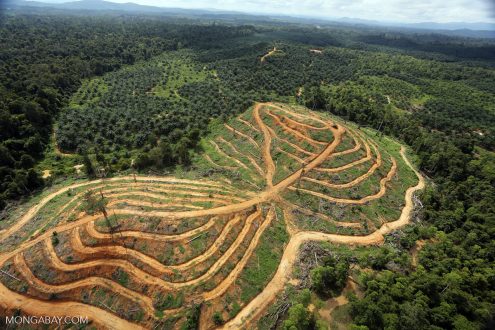Strata biodiiverzity: prirodzené vymieranie alebo problém spôsobený ľuďmi?
Príchod 2 votrelcov v 50-tych rokoch – reťazová píla a pásový traktor – mali pravdepodobne väčší vplyv ako akýkoľvek iný zavedený druh. Odvtedy je budovanie nových ciest kľúčovým faktorom meniacom Borneo. Cesty nie len poskytujú prístup ku komerčne hodnotným stromom, ale umožňujú aj prisťahovaleckým osadníkom, poľovníkom a špekulantom s pozemkami prístup k novým príležitostiam.
Svetový fond na ochranu prírody (World Wildlife Fund – WWF)
Na celom svete bolo vedcami popísaných približne 1,9 milión druhov, vrátane 1,000,000 druhov hmyzu, 310,000 druhov rastlín alebo 5,500 druhov cicavcov, čo môže predstavovať menej ako 15% v súčasnosti existujúcich druhov. Napriek kontroverzným odhadom v rozmedzí 5 – 100 miliónov druhov, s ohľadom na obmedzené vzorky, posledné vedecké odhady predpovedajú existenciu 9 miliónov druhov, vrátane 2 miliónov z nich žijúcich v oceánoch. Vlastne, každoročne je popísaných 5-10,000 nových druhov (väčšinou hmyz).
Z určitého hľadiska sa táto biodiverzita zdá byť skutočne obrovská. Na drhej strane je však bezpochyby vyčerpateľná a neobnoviteľná. Žiadna z vyhynutých foriem života, žiadny druh ani odroda, ktorá v minulosti zmizla, sa už nevyskytne v tej istej identite, napriek tomu, že bola nahradená mnohými inými. Aj keď sa odhaduje, že už vyhynulo viac ako 90% všetkých druhov (približne 100 miliónov druhov), ktoré kedy žili na Zemi, rôznorodosť života neustále vytvára svoje novú druhy. Toto sa nazýva prirodzené vymieranie. Takže v čom je problém?
Kvôli degradácii ekosystémov spôsobeného ľuďmi každoročne vyhynie takmer 10,000 druhov! Nenávratne a s následkami, vrátane vážnej škody s následkami, ktoré siahajú za hranicu únosnosti našej planéty. Ničenie biodiverzity je spojené so sociálnou nerovnosťou, keďže väčšina centier biodiverzity s vysokou mierou endemizmu sa nachádza a je devastovaná (napr. odlesňovanie) v krajinách globálneho Juhu. Je zjavné, že aj rôzne priemyselné aktivity na globálnom Severe môžu tiež viesť k vyhynutiu druhov.
Príklad? Takmer 60% chránených nížinných lesov v Indonézskej časti Bornea (Kalimantan) bolo odlesnených v období rokov 1985 až 2001, čo zodpovedá územiu s rozlohou Albánska. Podľa niektorých vedeckých prác, až 80% tropickej krajiny je degradovanej odlesnením, väčšinou kvôli ťažbe dreva a produkcii palmového oleja. Viete si predstaviť, koľko endemických druhov, jedinečných pre tieto oblasti, sa takto stratilo? Toto je veľmi ďaleko od prirodzeného vymierania. Naopak, táto katastrofa je následkom vplyvu spôsobeného činnosťou človeka.
Podľa Svetového fondu na ochranu prírody (WWF) „V Indonézii a Malajzii leží viac ako 90% území pre produkciu palmového oleja a význam týchto krajín pre túto komoditu sa v budúcnosti pravdepodobne bude zvyšovať, ako bude narastať dopyt.“ Preto sú potrebné ďalšie územia pre plantáže. Napr. v primárnych lesoch Malajzie možno nájsť asi 80 druhov cicavcov. Oproti tomu v narušených lesoch žije iba niečo cez 30 druhov cicavcov, kým na palmových plantážach je to iba asi 11-12 (Wakker 1998, in Clay (2004) “World Agriculture & Environment”). Tento pokles však platí pre všetky skupiny organizmov, vrátane rastlín, hmyzu, plazov alebo vtákov.
Location
Globally with Borneo as an example
Environmental impact
- Land degradation (e.g. drought, soil contamination, erosion and desertification)
- Biodiversity loss – Ecosystem destruction
- Depletion of natural resources (fossil and mineral, forest, water, etc)
Ethical/ legal issues
- Life and personal security
- Health and well-being
- A clean and prosperous environment and a safe and pleasant habitat
- Equality before the law and protection by the law (including marginalized and discriminated groups because of colour, race, gender, disability, descent, economic status, age, etc.)
- Opportunities to work and leisure
- Indigenous land, culture and rituals
- Access to public goods/ resources and products
- Personal and social development, economic progress and innovation
- Education and information
- Democratic participation to decision-making on community and national affairs
Information sources & materials
Online books and newspaper, magazine, encyclopedia, or blog articles
http://wwf.panda.org/what_we_do/footprint/agriculture/palm_oil/environmental_impacts/biodversity_loss/
http://wwf.panda.org/what_we_do/where_we_work/borneo_forests/borneo_deforestation/
http://journals.plos.org/plosone/article?id=10.1371/journal.pone.0159668
Links to images, online videos, documentary movies, etc
Many commitments, little transparency in cutting deforestation from corporate supply chains
http://www.eco-business.com/news/climate-cranks-extinction-threat-borneo-mammals/
Contributor(s)
Peter Fedor, Professor of Environmental Ecology



Home › Forums › Biodiversity loss: natural extinction or a human induced problem